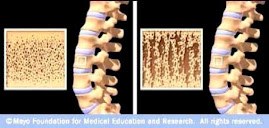“The greater increases in BMD are in part due to combined
anti-catabolic and bone anabolic effects of strontium ranelate and in part due to
the higher atomic number of strontium in bone as compared to calcium. The
higher atomic number of strontium (Z = 38) than calcium (Z = 20) leads to
greater attenuation of X-rays and consequently an overestimation of BMD as
measured by DXA (and expressed as calcium hydroxyapatite equivalent). The
greater changes in BMD are clinically useful, allowing the clinician to more
easily demonstrate positive changes in BMD as an indication of patient response
to therapy. With most osteoporosis therapies, BMD changes in individual
patients are likely to fall within the precision error for the densitometer.”
“Although various algorithms for adjusting the bone density
in patients on strontium ranelate therapy have been proposed, none are
validated. There are likely to be differences in strontium incorporation in
bone at different skeletal sites for many reasons. Strontium is preferentially
distributed in bone newly formed during strontium ranelate treatment rather
than in older bone, formed before treatment initiation. Strontium exchanges
more readily on the surface of bone than in deeper bone. It is therefore likely
that at different bone sites (trabecular and cortical bone), and with different
levels of bone turnover, bone strontium content would be quite variable between
individuals. Consequently, adjustment algorithms will not be clinically useful.”
“An adjustment of the lumbar spine BMD was first proposed in
the STRATOS study and has been used as an attempt to approximate the increase
in BMD related to the pharmacological effect of strontium ranelate. However,
this algorithm for adjustment of lumbar spine BMD is complex and based on
numerous assumptions.… By the above adjustment algorithm, it is estimated that
the BMD overestimation due to strontium in bone accounts for approximately 50%
of the measured change in BMD after 3 years of treatment.”
“The increased BMD observed clinically in patients treated
with strontium ranelate is both due to the presence of strontium in bone as
well as the pharmacological antiresorptive and anabolic activity on bone cells
resulting in increased bone tissue with normal bone calcium mineralization. In
animal studies, measured-BMD increases correlate with improved bone strength and
adjustment of the BMD does not improve the strength-BMD correlation compared
with the unadjusted BMD. This indicates that the measured, unadjusted BMD is
optimal in predicting improved biomechanical properties in patients on
strontium ranelate therapy. The easily discernible BMD increases in strontium ranelate-treated
patients will assure the clinician that medication has been ingested, that
strontium has been absorbed, and that anti-fracture efficacy in keeping with
the results from the pivotal trials can be expected.”



No comments:
Post a Comment